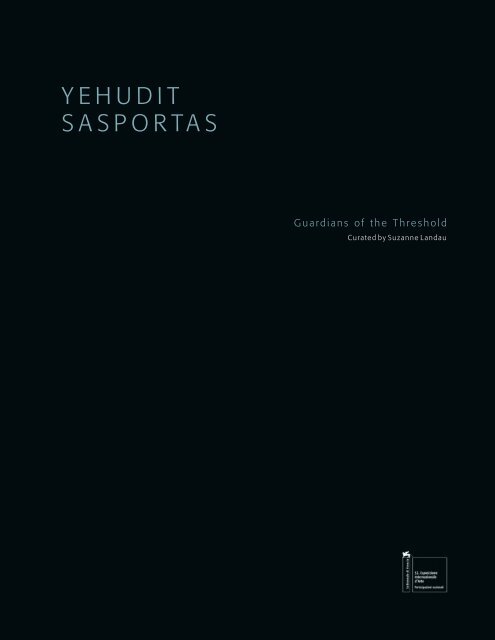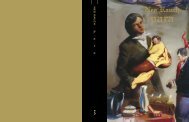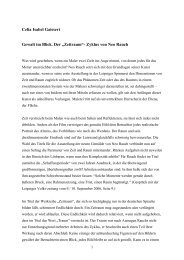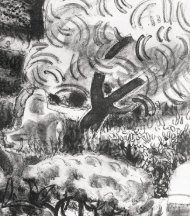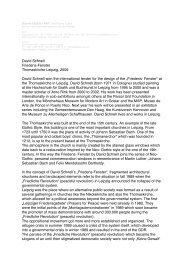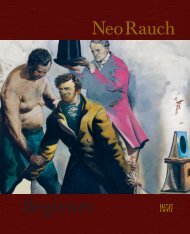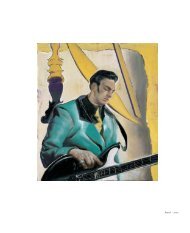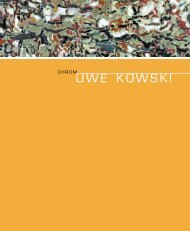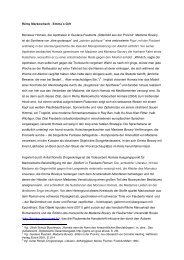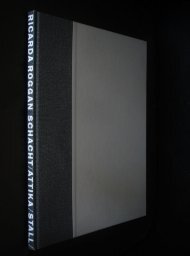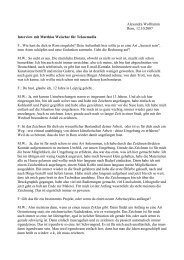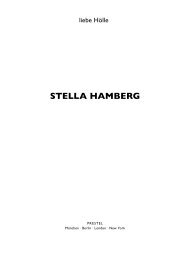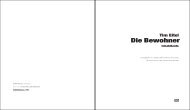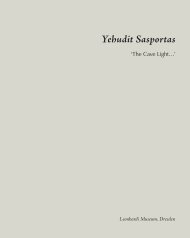YEHUDIT SASPORTAS - Galerie EIGEN+ART
YEHUDIT SASPORTAS - Galerie EIGEN+ART
YEHUDIT SASPORTAS - Galerie EIGEN+ART
You also want an ePaper? Increase the reach of your titles
YUMPU automatically turns print PDFs into web optimized ePapers that Google loves.
Y E H U D I T<br />
S A S P O R T A S<br />
G u a r d i a n s o f t h e T h r e s h o l d<br />
Curated by Suzanne Landau<br />
Innenseiten-05.indd 1 21.05.2007 0:15:41 Uhr
Yehudit Sasportas<br />
Guardians of the Threshold<br />
The Israeli Pavilion<br />
La Biennale di Venezia<br />
52nd International Art Exhibition<br />
Curator<br />
Suzanne Landau<br />
Yulla and Jacques Lipchitz<br />
Chief Curator of the Arts,<br />
The Landeau Foundation<br />
Curator of Contemporary Art,<br />
The Israel Museum, Jerusalem<br />
Production<br />
Production Manager: Diana Shoef<br />
Director of the Pavilion: Arad Turgeman<br />
Lighting: Yehuda Levi<br />
Assistants: Yifat Bezalel, Tal Peer,<br />
Sharon Mantel, Noa Lehrner<br />
Carpentry: Amir – A. A. Scenery; David<br />
Alon, Tel Aviv; Edgar Reinke and<br />
Raffi Leshem, Berlin<br />
3D-Imaging and Technical<br />
Consultant: Amos Wagon<br />
Technical Planning: Nomi Lewin<br />
Slide projection: Massimiliano Busato,<br />
MB Audiovisivi, Padova<br />
Catalogue<br />
Graphic Design: K. Marie Walter<br />
Photographs: Uwe Walter<br />
Graphic Design in Hebrew:<br />
Nadav Shalev<br />
Translations & Editing (Hebrew<br />
& English): Daria Kassovsky<br />
Translation (German): Frank Süßdorf<br />
Printing: Druckerei Conrad, Berlin<br />
Publishing<br />
DuMont Literatur und Kunst Verlag,<br />
Amsterdamer Strasse 9<br />
D-50735 Köln, Germany<br />
www. dumontliteraturundkunst.de<br />
The Israeli Council of<br />
Culture and Art<br />
Visual Art Section<br />
The Steering Committee<br />
Galia Bar-Or, Sergio Edelsztein,<br />
Yitzhak Livne, Michal Naaman,<br />
Meira Perry-Lehman<br />
Coordinator: Idit Amihai<br />
Ministry of Science, Culture<br />
and Sport<br />
Culture and Arts Administration,<br />
Museum & Visual Arts Department<br />
Ministry of Foreign Affairs<br />
Cultural & Scientific Affairs Division<br />
Embassy of Israel in Italy<br />
With support from<br />
Musicart ltd. founded by Mrs. Lily<br />
Elstein<br />
The Beracha Foundation<br />
ifa – Institut für Auslandsbeziehungen<br />
e. V.<br />
Robert J. Franklin, Santa Monica<br />
ACBP - The Andrea and Charles<br />
Bronfman Philanthropies<br />
Lauren & Mitchell Presser, New York<br />
Rivka Saker and Uzi Zucker<br />
Special thanks to<br />
Sommer Contemporary Art Gallery,<br />
Tel Aviv: Irit Mayer-Sommer, Ilan Fine,<br />
Tamar Zagursky, Ronili Lustig<br />
Gil Brandes and Doron Sebbag<br />
Shlomo Yitzhaki and Elena Lulko –<br />
Ministry of Science, Culture & Sport<br />
Yona Marcu – Ministry of Foreign Affairs<br />
<strong>Galerie</strong> EIGEN + ART Berlin<br />
Gerd Harry Lybke, Kerstin Wahala,<br />
Birte Kleemann, Ulrike Bernhard,<br />
Anne Schwanz, Sarah Miltenberger,<br />
Britta Grüter, Johanna Neuschäffer,<br />
Leonie Pfennig, Fiona Geuß<br />
<strong>Galerie</strong> EIGEN + ART Leipzig:<br />
Elke Hannemann, Astrid Hamm,<br />
Anja Meinhold<br />
The Center for Contemporary Art,<br />
Tel Aviv<br />
American Friends of the Israel<br />
Museum<br />
The Israel Museum, Jerusalem<br />
Israel Cultural Excellence Foundation<br />
(IcExcellence)<br />
Aviv Koriat<br />
Irad Kimchi; Shlomit Divinsky<br />
Doron Fitterman – Gravity<br />
Post Production<br />
Avi Reik – Flying Cargo<br />
Arc. Giovanni Boldrin, Padova;<br />
Aurellio Rampazzo Srl. Impresa edile,<br />
Venezia<br />
Andrea Morandi, Padova<br />
All works courtesy of<br />
Sommer Contemporary Art, Tel Aviv<br />
www. sommergallery.com<br />
<strong>Galerie</strong> EIGEN + ART Leipzig/Berlin<br />
www. eigen-art.com<br />
© 2007 Yehudit Sasportas and<br />
DuMont Verlag<br />
ISBN: 978 3 83 7773 7<br />
Innenseiten-05.indd 2 21.05.2007 0:15:41 Uhr
Innenseiten-05.indd 3 21.05.2007 0:15:41 Uhr<br />
3
G U A R D I A N S O F<br />
Innenseiten-05.indd 4 21.05.2007 0:15:50 Uhr
T H E T H R E S H O L D<br />
Site – specific installation<br />
Ink, acr ylic, oil, chalk,<br />
Slide projection,<br />
Ply wood, metal, MDF<br />
Dimension variable<br />
Innenseiten-05.indd 5 21.05.2007 0:15:56 Uhr<br />
5
Innenseiten-05.indd 6 21.05.2007 0:16:02 Uhr
Innenseiten-05.indd 7 21.05.2007 0:16:06 Uhr<br />
7
8<br />
Innenseiten-05.indd 8 21.05.2007 0:16:12 Uhr
Innenseiten-05.indd 9 21.05.2007 0:16:16 Uhr<br />
9
0<br />
Innenseiten-05.indd 10 21.05.2007 0:16:21 Uhr
Innenseiten-05.indd 11 21.05.2007 0:16:26 Uhr
Innenseiten-05.indd 12 21.05.2007 0:16:31 Uhr
Innenseiten-05.indd 13 21.05.2007 0:16:36 Uhr<br />
3
Innenseiten-05.indd 14 21.05.2007 0:16:41 Uhr
Innenseiten-05.indd 15 21.05.2007 0:16:46 Uhr<br />
5
Innenseiten-05.indd 16 21.05.2007 0:16:51 Uhr
Innenseiten-05.indd 17 21.05.2007 0:16:55 Uhr<br />
7
8<br />
Innenseiten-05.indd 18 21.05.2007 0:17:01 Uhr
Innenseiten-05.indd 19 21.05.2007 0:17:05 Uhr<br />
9
0<br />
Innenseiten-05.indd 20 21.05.2007 0:17:11 Uhr
Innenseiten-05.indd 21 21.05.2007 0:17:15 Uhr
Innenseiten-05.indd 22 21.05.2007 0:17:21 Uhr
Innenseiten-05.indd 23 21.05.2007 0:17:25 Uhr<br />
3
Innenseiten-05.indd 24 21.05.2007 0:17:31 Uhr
Innenseiten-05.indd 25 21.05.2007 0:17:35 Uhr<br />
5
Innenseiten-05.indd 26 21.05.2007 0:17:40 Uhr
Innenseiten-05.indd 27 21.05.2007 0:17:45 Uhr<br />
7
8<br />
Innenseiten-05.indd 28 21.05.2007 0:17:50 Uhr
Innenseiten-05.indd 29 21.05.2007 0:17:55 Uhr<br />
9
30<br />
Innenseiten-05.indd 30 21.05.2007 0:18:00 Uhr
Innenseiten-05.indd 31 21.05.2007 0:18:04 Uhr<br />
3
3<br />
Innenseiten-05.indd 32 21.05.2007 0:18:10 Uhr
Innenseiten-05.indd 33 21.05.2007 0:18:14 Uhr<br />
33
3<br />
Innenseiten-05.indd 34 21.05.2007 0:18:21 Uhr
Threshold and its Shadow (for YS)<br />
Andrew Renton<br />
The intention of one who contemplates an image is said<br />
to go directly through the image, as through a window,<br />
into the world it represents, and aims at an object … 1<br />
The view from here makes you long for an absent scene.<br />
Despite all reference and materialization, the work establishes<br />
a paradox of representation, where illusion can be understood<br />
as a device or strategy to distance the viewer from the scene.<br />
It is always presented as illusion and is driven by a desire<br />
perpetually deferred and unfulfilled. The distance is defined<br />
both in terms of the illusion itself, what it looks like to you,<br />
from here, and also through the means of making, with what<br />
means you imagine it might have been put together.<br />
You do not see what is represented, but rather see through<br />
a representation on the way towards it. There is no way to<br />
forget that this is a constructed sightline, whose purpose<br />
is to ask the viewer to look beyond. But the means are<br />
inadequate. They reveal their failure to represent. Absolute<br />
representation, after all, is invisibility or transparency. You<br />
would pass through the thing entirely. You would not see it<br />
for the illusion it was.<br />
You come to rely upon the artifice as a device to alert you<br />
to the limitations of looking. You need things to get in the way,<br />
or to appear not quite right. You relish an idea of genre and<br />
its occasional failure for the opacity it produces.<br />
‹ ‹ ‹<br />
As in a desert, one can find no place to reside … 2<br />
You always carry something with you. Something of the old<br />
place. The old place as you remember it, or as you imagine<br />
it might have been.<br />
Or another place, quite different, impossible to name. You<br />
were never there; you only believe you remember. Or you<br />
construct an image of the place from the stories you have<br />
heard or absorbed over the years. And there came a time<br />
when you could no longer distinguish between those old<br />
stories and the recollections of unmediated experience.<br />
It is always a case of looking out of the window. But you<br />
are hardly able to take in the view, as your eye looks away,<br />
perhaps to one side or another. You become aware of the<br />
window and the way that it frames the scene. Inadvertently<br />
the frame displaces what it contains and your eye wavers<br />
between the window and some sort of generic view offered<br />
in reproduction.<br />
Light enters your room, but the perspective beyond the<br />
room casts little or no shadow upon where you stand. The<br />
light moves around the room so slowly that the day might<br />
come and go and you would hardly notice your own shadow<br />
except when it obscured your sightline.<br />
But the image of the thing incorporates the object and<br />
its shadow into itself to such a degree that they become<br />
one. They belong to the same flat plane of illusion, even as<br />
everything you know of the scene would mitigate against<br />
that flatness.<br />
An exaggerated image of the scene, more visible precisely<br />
because it announces itself as a visual fiction of sorts, with<br />
saturated color. You unsee its frameless edges, dismissing<br />
any notion of a border to allow your eye to enter for one<br />
moment before it turns away.<br />
But were you ever there? Did you ever step outside into<br />
this scene you are attempting to frame?<br />
To what extent, you wonder, is witnessing essential to the<br />
configuration of the landscape, or even to its understanding?<br />
You might think to mark your relationship by your memory of<br />
it. But you were never there, and there is no return. Because<br />
even were your memory without flaw or lapse, the landscape<br />
of your youth or the landscape of your father is never still. It<br />
moves on, displacing its own image to the point of no return.<br />
Virtual by another name, in that it would not cast a shadow.<br />
‹ ‹ ‹<br />
And forgetting turns away from a past instant but keeps<br />
a relationship with what it turns away from … 3<br />
Or perhaps you are drawn to an act of removal, where<br />
the space or gap that remains subsequent to that removal<br />
becomes the site or object of contemplation.<br />
You cannot be sure where the space or hole begins or ends.<br />
You have neither the terms of reference nor the instruments<br />
to define the elements that prescribe it. You must approach<br />
it from several perspectives. In material terms the space or<br />
hole signals an absence of something. But you might require<br />
confirmation of that absence; it materializes, paradoxically,<br />
Innenseiten-05.indd 39 21.05.2007 0:18:31 Uhr<br />
39
only through its lack. You might come to dig, for example, in<br />
the grounds beyond your window, but leave the rubble by<br />
the side by way of confirmation.<br />
Or another version. You compress the earth with your palm<br />
or finger and create an indentation in the ground. A space or<br />
hole of sorts, yet with no apparent removal or displacement.<br />
And another version still, where you construct a vessel<br />
with the express intention that it should hold nothing but the<br />
apparent void that inevitably occurs within its walls or planes.<br />
Of course it is never truly void or absent.<br />
You could never be sure where the space or hole begins or<br />
ends. Is the hole merely the space signaled by absent material,<br />
or must it be constituted by the surrounding ‘skin’ of material?<br />
You have, as a consequence of this paradox, come to see the<br />
space or hole in quite material terms. A negative theology of<br />
sorts, where what cannot be represented is defined only in<br />
terms of what it is not.<br />
In this space you observe that the work comes to reflect<br />
back upon itself in the manner of a mirror. In the absence<br />
of a subject there is only reflection upon the means through<br />
which it is seen.<br />
But this mechanism transforms the representation, rendering<br />
it unfamiliar, even as it replicates the scene. You do not<br />
recognize yourself, even, when you look in the mirror, let<br />
alone the reflected scene. Your eye strains for detail or feature<br />
that you might recall or recognize. You still believe that you<br />
might know this place, that you might have once called it<br />
home or thereabouts.<br />
0<br />
‹ ‹ ‹<br />
It is already here from the other side of the wall … 4<br />
The landscape is always highly charged. You come to the<br />
land and reclaim it as your own. You mark the space with<br />
posts or boundaries. But more than this you remake the<br />
terrain, reorganize its nature into a form you might recognize<br />
or one that reminds you of another time and place.<br />
Landscape, here, defines itself as genre without limit. An<br />
idealized form of representation that anticipates its making. It<br />
conforms to a history of making. And it situates you within it<br />
to such a degree that you are implicated with every contour<br />
or line.<br />
There is a sense of collective ownership to landscape; it<br />
retains markers of recognition, however abstracted. But this<br />
abstraction is rarely articulated, in that we carry with us assumptions<br />
of witnessing. You believe that where you stand in<br />
relation to the object in front of you is a site marked by where<br />
its maker once might have stood. You may not witness the<br />
scene directly, but you may always be witness to its making.<br />
The landscape may yet come to serve a symbolic end, but its<br />
origins lie in the translation of one mark for another; a siting in<br />
the simplest sense. You both mark your place and abandon it.<br />
And still you carry it with you in some shape or form.<br />
You are drawn to negotiate beyond the view, such as it is.<br />
You live under the illusion that the landscape is always ‘found’,<br />
a blueprint of what will come to be rendered, and exists as a<br />
manifestation of witnessing, of having been on the spot. The<br />
landscape painting marks place by remaking it and removing<br />
it to other parts. It becomes a memory of that witnessing, a<br />
secondary experience, of an apparently lived encounter.<br />
But that encounter must always be viewed with suspicion.<br />
How could we be certain that there is any correlation between<br />
what was there and what was seen? Between what was<br />
observed and what was rearticulated in its image or shadow?<br />
The means of representation are deliberately restricted. They<br />
acquire three dimensions through frames and windows, but<br />
the surface is a simplified ritual of colorless line.<br />
Even full reference to the genre at stake cannot lend a<br />
name to these renderings that operate somewhere between<br />
two and three dimensions. Or more precisely, to a space<br />
defined through a series of willfully flat surfaces, with the hand<br />
working away, inching across surface, but without inflection or<br />
accent. It could only have been made by hand, and yet it is<br />
not at all about the hand. Or a particular hand, at least.<br />
(But whose marks? In whose name? What style or deliberation<br />
do they betray?)<br />
‹ ‹ ‹<br />
In contact itself the touching and the touched<br />
separate … 5<br />
The threshold does not demarcate or separate, although<br />
it might give that impression. It is an indeterminate space<br />
that provides passage between one space and another. But<br />
Innenseiten-05.indd 40 21.05.2007 0:18:31 Uhr
only through its lack. You might come to dig, for example, in<br />
the grounds beyond your window, but leave the rubble by<br />
the side by way of confirmation.<br />
Or another version. You compress the earth with your palm<br />
or finger and create an indentation in the ground. A space or<br />
hole of sorts, yet with no apparent removal or displacement.<br />
And another version still, where you construct a vessel<br />
with the express intention that it should hold nothing but the<br />
apparent void that inevitably occurs within its walls or planes.<br />
Of course it is never truly void or absent.<br />
You could never be sure where the space or hole begins or<br />
ends. Is the hole merely the space signaled by absent material,<br />
or must it be constituted by the surrounding ‘skin’ of material?<br />
You have, as a consequence of this paradox, come to see the<br />
space or hole in quite material terms. A negative theology of<br />
sorts, where what cannot be represented is defined only in<br />
terms of what it is not.<br />
In this space you observe that the work comes to reflect<br />
back upon itself in the manner of a mirror. In the absence<br />
of a subject there is only reflection upon the means through<br />
which it is seen.<br />
But this mechanism transforms the representation, rendering<br />
it unfamiliar, even as it replicates the scene. You do not<br />
recognize yourself, even, when you look in the mirror, let<br />
alone the reflected scene. Your eye strains for detail or feature<br />
that you might recall or recognize. You still believe that you<br />
might know this place, that you might have once called it<br />
home or thereabouts.<br />
0<br />
‹ ‹ ‹<br />
It is already here from the other side of the wall … 4<br />
The landscape is always highly charged. You come to the<br />
land and reclaim it as your own. You mark the space with<br />
posts or boundaries. But more than this you remake the<br />
terrain, reorganize its nature into a form you might recognize<br />
or one that reminds you of another time and place.<br />
Landscape, here, defines itself as genre without limit. An<br />
idealized form of representation that anticipates its making. It<br />
conforms to a history of making. And it situates you within it<br />
to such a degree that you are implicated with every contour<br />
or line.<br />
There is a sense of collective ownership to landscape; it<br />
retains markers of recognition, however abstracted. But this<br />
abstraction is rarely articulated, in that we carry with us assumptions<br />
of witnessing. You believe that where you stand in<br />
relation to the object in front of you is a site marked by where<br />
its maker once might have stood. You may not witness the<br />
scene directly, but you may always be witness to its making.<br />
The landscape may yet come to serve a symbolic end, but its<br />
origins lie in the translation of one mark for another; a siting in<br />
the simplest sense. You both mark your place and abandon it.<br />
And still you carry it with you in some shape or form.<br />
You are drawn to negotiate beyond the view, such as it is.<br />
You live under the illusion that the landscape is always ‘found’,<br />
a blueprint of what will come to be rendered, and exists as a<br />
manifestation of witnessing, of having been on the spot. The<br />
landscape painting marks place by remaking it and removing<br />
it to other parts. It becomes a memory of that witnessing, a<br />
secondary experience, of an apparently lived encounter.<br />
But that encounter must always be viewed with suspicion.<br />
How could we be certain that there is any correlation between<br />
what was there and what was seen? Between what was<br />
observed and what was rearticulated in its image or shadow?<br />
The means of representation are deliberately restricted. They<br />
acquire three dimensions through frames and windows, but<br />
the surface is a simplified ritual of colorless line.<br />
Even full reference to the genre at stake cannot lend a<br />
name to these renderings that operate somewhere between<br />
two and three dimensions. Or more precisely, to a space<br />
defined through a series of willfully flat surfaces, with the hand<br />
working away, inching across surface, but without inflection or<br />
accent. It could only have been made by hand, and yet it is<br />
not at all about the hand. Or a particular hand, at least.<br />
(But whose marks? In whose name? What style or deliberation<br />
do they betray?)<br />
‹ ‹ ‹<br />
In contact itself the touching and the touched<br />
separate … 5<br />
The threshold does not demarcate or separate, although<br />
it might give that impression. It is an indeterminate space<br />
that provides passage between one space and another. But<br />
Innenseiten-05.indd 40 21.05.2007 0:18:31 Uhr
it is hardly a line drawn in the sand, or a mark of finality.<br />
The threshold is a state of mind through which you may or<br />
may not pass. A remnant of utopia, of an apparently neutral<br />
territory, if you could conceive of such a place. Where you do<br />
not know where you were.<br />
Again, it is a matter of faith. Faith in the image the threshold<br />
has constructed before you. Suspension of disbelief, perhaps,<br />
to put it in another way.<br />
But rare are the times that you are sufficiently close to it<br />
that such indistinction occurs. You cannot be sure whether<br />
the threshold is for you to pass through or to avoid. A nonspace<br />
or a line, for which it is convenient, if not necessary,<br />
according to the laws of nature, to consider as having no width<br />
at all. A moment that defies stasis or punctum, that resists<br />
definition or site.<br />
The threshold sets you in perpetual motion, moving you<br />
from one space to another, momentarily defining the spaces<br />
through which you pass.<br />
‹ ‹ ‹<br />
A past that is articulated – or ‘thought’ – without recourse<br />
to memory, without a return to living presents, and that<br />
is not made up of representations … 6<br />
Towards another view from the window. Or a view of a<br />
view. Because it always depends on how far back from the<br />
scene you might choose to stand, and what might interrupt<br />
your view with that retreat. Perspective begins with the definition<br />
of what is observed from the position of the observer.<br />
Here, then, the object is embodied by the motion through<br />
it. You move through this space, testing it by virtue of your<br />
own embodiment. And since you are rarely if ever still, the<br />
perspective shifts under your feet. It is never the same, from<br />
one glance to the next.<br />
Looking out, or looking over, or looking through. The scene<br />
exceeds itself, through reflection or shadow. You cannot be<br />
sure which. But the matter of both remains.<br />
London, February 007<br />
Notes<br />
Emmanuel Lévinas, “Reality and Its Shadow,” trans. Alphonso Lingis, in<br />
ed. Seán Hand, The Lévinas Reader (Oxford: Blackwell, 989), p. 3 .<br />
Emmanuel Lévinas, Proper Names, trans. Michael B. Smith (Stanford:<br />
Stanford UP, 99 ), p. 3 .<br />
3 Ibid. p. 5.<br />
Ibid. p. .<br />
5 Emmanuel Lévinas, Otherwise than Being or Beyond Essence, trans.<br />
Alphonso Lingis (The Hague: Martinus Nijhoff, 98 ), p. 8 .<br />
Emmanuel Lévinas, Entre Nous: Thinking-of-the-Other, trans. Michael B.<br />
Smith, Barbara Harshav (London: Continuum, 00 ), p. 8.<br />
Innenseiten-05.indd 41 21.05.2007 0:18:31 Uhr
Biographical Notes<br />
1969 Born in Ashdod, Israel<br />
Since Teaches at the Department of Fine Arts,<br />
1993 Bezalel Academy of Art and Design,<br />
Jerusalem<br />
Lives and works in Berlin and Tel Aviv<br />
Education<br />
1997–99 MFA studies, Department of Fine Arts,<br />
Bezalel Academy of Art and Design, Jerusalem<br />
in conjunction with the Faculty of Humanities,<br />
the Hebrew University, Jerusalem<br />
1993 Sculpture Department, The Cooper Union<br />
School of Art, New York<br />
1989–93 BFA, Department of Fine Arts, Bezalel Academy<br />
of Art and Design, Jerusalem<br />
Scholarships and Awards<br />
2004–05 Artist-in-Residence, Künstlerhaus Bethanien,<br />
Berlin<br />
2003–05 The Chosen Artist, Israel Cultural Excellence<br />
Foundation (ICExcellence)<br />
2003 Artist-in-Residence, Binz Foundation, Nairs,<br />
Switzerland<br />
2001 Arthur Goldreich Foundation, Bezalel<br />
Academy of Art and Design, Jerusalem<br />
1999 The Nathan Gottesdiener Foundation,<br />
The Israeli Art Prize, Tel Aviv Museum of Art<br />
1998 Gotsy Reder Prize for Sculpture, Herzliya<br />
Museum of Art<br />
1996 Young Artist Award, the Israeli Ministry of<br />
Education and Culture<br />
Kadishman Prize for Sculpture, The America-<br />
Israel Cultural Foundation<br />
Ingeborg Bachmann Scholarship, established<br />
by Anselm Kiefer, The Wolf Foundation<br />
1994–98 The Sharet Scholarship, The America-Israel<br />
Cultural Foundation<br />
Helena Rubinstein Prize for Sculpture, The<br />
Israel-America Cultural Foundation<br />
1993 Ehud Elhanani Prize for Academic Excellence,<br />
Department of Fine Arts, Bezalel Academy of<br />
Art and Design, Jerusalem<br />
Roman Steinmann Award for Sculpture,<br />
Herzliya Museum of Art, Israel<br />
One-Person Exhibitions<br />
2008 Sommer Contemporary Art, Tel Aviv<br />
2007 “Guardians of the Threshold,” The Israeli<br />
Pavilion, The 5 nd International Art<br />
Exhibition, Venice Biennale (cat.; texts:<br />
Suzanne Landau, Andrew Renton)<br />
2006 “The Guardian of the Pearl’s Shadow,”<br />
St. Lukas Gallery, Brussel (cat.; text:<br />
Filip Luyckx)<br />
2005 “The Cave Light,” Leonhardi Museum,<br />
Dresden (cat.; text: Christoph Tannert)<br />
“The Pomegranate Orchard,” <strong>Galerie</strong><br />
<strong>EIGEN+ART</strong>, Berlin<br />
2004 “Guardian of the Pearl’s Shadow,” Sommer<br />
Contemporary Art, Tel Aviv<br />
“Locher,” Müllerhaus, Literatur und Sprache,<br />
Lenzburg, Switzerland<br />
“Guardian of the Pearl‘s Shadow ,”<br />
Roberts & Tilton Gallery, Los Angeles<br />
2003 “The Swamp and the Magnetic Ants,”<br />
<strong>Galerie</strong> <strong>EIGEN+ART</strong>, Leipzig<br />
2002 “By the River,” Matrix 00 UC, Berkeley Art<br />
Museum, University of California<br />
(cat.; text: Heidi Zuckerman Jacobson)<br />
“The Archive, Artist‘s Statement,” Art Cologne<br />
2001 “The Carpenter and the Seamstress ,”<br />
Deitch Projects, New York<br />
“How did it ever come so far… ,” <strong>Galerie</strong><br />
<strong>EIGEN+ART</strong>, Berlin<br />
2000 “The Carpenter and the Seamstress,” The<br />
Nathan Gottesdiener Foundation, The Israeli<br />
Art Prize 999, Tel Aviv Museum of Art<br />
Innenseiten-05.indd 42 21.05.2007 0:18:31 Uhr
(cat.; texts: Ellen Ginton, Avi Ifargan,<br />
David Hunt, Elizabeth Janus)<br />
1999 “PVC 999,” Noga Gallery of Contemporary<br />
Art, Tel Aviv<br />
1996 “Trash-Can Scale: Works ‘95 – ’9 ,” Janco<br />
Dada Museum, Ein Hod, Israel<br />
(cat.; text: Yona Fischer)<br />
1995 “Mapping,” Office in Tel Aviv Gallery, Tel Aviv<br />
(cat.; text: Rachel Sukman)<br />
1994 “Drawings,” as part of the series Nidbach<br />
(Layer), The Artists House, Jerusalem<br />
Selected Group Exhibitions<br />
2008 “Israel Now: Contemporary Israeli Art,”<br />
The Jewish Museum, Frankfurt am Main (cat.)<br />
“Ornament and Pride,” S.M.A.K., Gent,<br />
Belgium (cat.)<br />
2007 “Ausgezeichnet,” Kunstverein Freiburg,<br />
Germany<br />
“Neue Heimat,” Berlinische <strong>Galerie</strong>,<br />
Berlin (cat.)<br />
“Digital Landscapes,” The Genia Schreiber<br />
University Art Gallery, Tel Aviv University<br />
(cat.)<br />
2006 “The Raft of the Medusa: Israeli Art and the<br />
Monster of Self Identity,” National Museum,<br />
Warsaw & Krakow (cat.)<br />
“All the Best: The Deutsche Bank Collection<br />
and Zaha Hadid,” Singapore Art Museum<br />
“Far and Away: The Fantasy of Japan in<br />
Contemporary Israeli Art,” The Israel Museum,<br />
Jerusalem (cat.)<br />
“Mini Israel: 70 Models, 5 Artists, One<br />
Space,” The Israel Museum, Jerusalem (cat.)<br />
2005 “Yona at Bezalel: Yona Fischer‘s Oeuvre and<br />
Issues in Contemporary Curatorship,” Bezalel<br />
Academy Gallery, Tel Aviv (cat.)<br />
“The Phoenix Collection,” Ashdod Museum<br />
of Art, Israel (cat.)<br />
“ 5 Jahre Sammlung Deutsche Bank,”<br />
Deutsche Guggenheim, Berlin<br />
“Temporary Import,” Art Forum, Berlin<br />
“Portrait,” <strong>Galerie</strong> <strong>EIGEN+ART</strong>, Berlin<br />
“Dreaming Art / Dreaming Reality – The<br />
Nathan Gottesdiener Foundation, The Israeli<br />
Art Prize: The First Decade,” Tel Aviv<br />
Museum of Art (cat.)<br />
“Die Neuen Hebraer: 00 Jahre Kunst in<br />
Israel,” Martin-Gropius-Bau, Berlin (cat.)<br />
2004 “Point of View,” Tel Aviv Museum of Art (cat.)<br />
“Drawing Now,” Centro de Arte<br />
Contemporáneo de Málaga (CAC), Spain (cat.)<br />
“European Portrait, Part ,” Rohkunstbau, Gross<br />
Leuthen, Brandenburg, Germany (cat.; text:<br />
Mark Gisbourne)<br />
“Sommer Contemporary Art at Lehmann<br />
Maupin Gallery,” New York<br />
“Romantica,” Sommer Contemporary Art,<br />
Tel Aviv<br />
2003 “Chopsticks,” Hamidrasha Gallery, Tel Aviv<br />
“Sommer Contemporary Art at Kilchmann<br />
Plus,” Zurich<br />
“Chilufim: Exchange of Artists and Art, Israel<br />
– North Rhine-Westphalia,” Kunstmuseum<br />
Bonn; Kaiser Wilhelm Museum, Krefeld;<br />
Museum am Ostwall, Dortmund (cat.; text:<br />
Christina Végh)<br />
“Art in Engiadina Bassa,” Kulturzentrum,<br />
Nairs, Switzerland<br />
2002 “Recent Acquisitions: Purchased by the Uzi<br />
Zucker Fund for Contemporary Art,” Tel Aviv<br />
Museum of Art (cat.; text: Ellen Ginton)<br />
“Kill Me If You Can,” Rachel and Israel Pollak<br />
Gallery, Kalisher School of Art, Tel Aviv<br />
“Personal Plans,” Kunsthalle Basel (cat.; text:<br />
Christina Végh)<br />
“Imagine,” Umm el-Fahem Art Gallery, Israel<br />
“Sommer Contemporary Art at Sadie Coles<br />
HQ,” London<br />
“Chilufim: Exchange of Artists and Art,<br />
Israel – North Rhine-Westphalia,” Herzliya<br />
Museum of Art, Israel; The Israel Museum,<br />
Jerusalem (cat.)<br />
Innenseiten-05.indd 43 21.05.2007 0:18:32 Uhr<br />
3
2001 “Walkabout,” The Museum of Israeli Art,<br />
Ramat Gan, Israel; <strong>Galerie</strong> Kampnagel,<br />
Hamburg (cat.)<br />
“Las Pasiones,” Valencia Biennial, Spain (cat.)<br />
“Total Object Complete with Missing Parts,”<br />
Tramway, Glasgow<br />
Barbara Davis Gallery, Houston, Texas<br />
“Works on Paper,” Kerlin Gallery, Dublin<br />
2000 “Platforma,” Sommer Contemporary Art,<br />
Tel Aviv<br />
“Ladies and Gentlemen: Contemporary<br />
Israeli Art,” Tel Aviv Museum of Art<br />
1999 “The Passion and the Wave,” th International<br />
Istanbul Biennial (cat.; text: Paolo Colombo)<br />
“Young International Art,” <strong>Galerie</strong><br />
<strong>EIGEN+ART</strong>, Berlin<br />
“Art Focus 3,” International Biennial for<br />
Contemporary Art, Sultan’s Pool, Jerusalem<br />
(cat.; text: Kasper König)<br />
“Good Kids, Bad Kids: ‘Childliness’ in Israeli<br />
Art,” The Israel Museum, Jerusalem (cat.)<br />
“The Biennial of the Mediterranean,” Rome (cat.)<br />
1998 “Bamot: The Building, Destruction and<br />
Restoration of High Places, Israel 9 8 – 998,”<br />
The Jewish Museum, Vienna (cat.)<br />
“ ²,” The Bezalel Graduate Program for<br />
Young Artists, Morris Louis Gallery,<br />
Bezalel Academy of Art and Design, Jerusalem<br />
“90 Years of Israeli Art: A Selection from<br />
the Joseph Hackmey-Israel Phoenix<br />
Collection,” Tel Aviv Museum of Art (cat.;<br />
text: Miri Ben Moshe)<br />
“Women Artists in Israel, 9 8 – 998,”<br />
Haifa Museum of Art, Israel (cat.)<br />
“Four Israeli Artists,” Art Triennial, New<br />
Delhi (cat.)<br />
1997 “Home,” Anadiel Gallery, East Jerusalem<br />
“The Biennale for Young Artists from Europe<br />
and the Middle East,” Turin, Italy; Helsinki,<br />
Finland (cat.)<br />
1996 “Yehudit Sasportas and Smadar Eliasaf:<br />
Drawings,” Noga Gallery of Contemporary Art,<br />
Tel Aviv<br />
“Balanced,” The Artists‘ House, Tel Aviv<br />
1995 “Michael Kassuss Gedalyovich, Yehudit<br />
Sasportas,” Dafna Ron, The Artists‘ Studios,<br />
Tel Aviv<br />
“Drawing no. ,” Gimmel Gallery, Jerusalem<br />
“Autumn Salon,” squatting project in<br />
abandoned house in Tel Aviv<br />
“Eight Artists,” America-Israel Cultural<br />
Foundation, Alice Tully Hall, New York<br />
“L.A. International, Biennial Invitational,”<br />
Posner Fine Art, Santa Monica, California<br />
1994 “Back,” Gimmel Gallery, Jerusalem<br />
“Separate Worlds,” as part of Art Focus,<br />
Tel Aviv Museum of Art (cat.)<br />
“Home-Works,” Herzliya Museum of Art;<br />
The Art Gallery, University of Haifa;<br />
The Yavneh Art Workshop; Arad Museum,<br />
Israel (cat.)<br />
1993 “Labyrinth,” Studio Patt, Jerusalem<br />
Innenseiten-05.indd 44 21.05.2007 0:18:35 Uhr
Innenseiten-05.indd 45 21.05.2007 0:18:40 Uhr<br />
5
Additional Bibliography<br />
Mark Gisbourne, “Yehudit Sasportas,” in Kunst<br />
Station Berlin, ed. Ulf Meyer zu Küingdorf (Munich:<br />
Knesebeck, 00 ), pp. 70 – 79 [German].<br />
“Yehudit Sasportas: Die Hierarchie der Dinge,”<br />
Interview, Modernica Magazine, no. , Welt<br />
Edition, Sept. 00 [German].<br />
Samuel Klein, “Secrets of the Forest and River,”<br />
The Jewish Quarterly, Spring 00 , pp. 3 – 8.<br />
Walter Soltau, “Zwei Wälder in Dresden,”<br />
Jüdische Zeitung, Jan. 00 [German].<br />
Corinna Daniels, “Landschaft als Bühne:<br />
Zeichnungen von Sasportas,” Die Welt, no. 87,<br />
Aug. 005, pp. 3 – 3 [German].<br />
Gabriele Thiels, “Mein Geist ist ein Garten,”<br />
Welt am Sonntag, 7 Aug. 005, p. 50 [German].<br />
Ruthe Ingeborg, “Sintflut überm Hochgebirge,”<br />
Berliner Zeitung, 30 July 005, p. 9 [German].<br />
Carmen Böker, “Tannenwald im Tuschemeer,”<br />
Berliner Zeitung, July 005 [German].<br />
Lutz Cosima, “Beschriebene Blätter,” Die Welt,<br />
8 May 005 [German].<br />
Talya Halkin, “Domestic Nightmare,” The Jerusalem<br />
Post, 7 Feb. 00 .<br />
Yoav Shmueli, “Go One Floor Up,” Time Out<br />
Tel Aviv, Feb. 00 [Hebrew].<br />
Uzi Zur, “Bone Halo,” Haaretz, 0 Feb. 00 [Hebrew].<br />
Ruti Direktor, “Just cause she feels like talking,”<br />
Ha‘ir, 3 Feb. 00 [Hebrew].<br />
Irit Tamari, “Guardian of the Pearl’s Shadow,”<br />
Time Out Tel Aviv, Feb. 00 [Hebrew].<br />
Smadar Sheffi, “Beauty Digested in Full,”<br />
Haaretz, 9 Feb. 00 [Hebrew].<br />
Shva Salhoov, “The Angel of Hysteria: About<br />
Yehudit Sasportas‘s New Work, By the River,” Studio<br />
Israeli Art Magazine, 7, Oct. 003, pp. – 39 [Hebrew].<br />
“Israel Cultural Excellence Foundation has<br />
Chosen Yehudit Sasportas,” Studio Israeli Art<br />
Magazine, , July 003, pp. 8 – 0 [Hebrew].<br />
Barry Schwabsky, “Yehudit Sasportas, Berkley<br />
Art Museum,” Artforum, Feb. 003, p. .<br />
Lydia Lee, “Israeli Artists Seek Beauty when it seems‚<br />
Life isn’t Logical,” Jewish Bulletin 0 / 9,<br />
3 Dec. 00 .<br />
Elizabeth Mahoney, “Total Object Complete<br />
with Missing Parts: Tramway, Glasgow,” Art<br />
Monthly, 50, Oct. 00 , pp. 3 – 38.<br />
Danny Yahav-Brown, “Yehudit Sasportas at<br />
Deitch Projects, New York,” Studio Israeli Art<br />
Magazine, , March – Apr. 00 , pp. 73 – 7 [Hebrew].<br />
Michal Karpik-Marcus, “Down the Paths of<br />
Wonderland,” Muse Art Quarterly, no. 3, Jan. 00 ,<br />
The Israel Museum, Jerusalem, pp. – 5 [Hebrew].<br />
Ruti Direktor, “No Place Like Home,” Ha‘ir,<br />
8 June 000 [Hebrew].<br />
Dalia Karpel, “Cover Story,” Interview, Haaretz,<br />
May 000 [Hebrew].<br />
Uzi Zur, “Intimate Battlefields,” Haaretz,<br />
May 000 [Hebrew].<br />
David Hunt, “The Sixth International Istanbul<br />
Biennial,” Artext, Feb. – Apr. 000, p. 9 .<br />
Gregory Volk, “Dispatches: The Passion and<br />
Innenseiten-05.indd 46 21.05.2007 0:18:40 Uhr
the Wave, The th Istanbul Biennial,”<br />
Sculpture, vol. 9, no. , Jan. – Feb. 000, pp. 70 – 7 .<br />
Adi Efal, “Yehudit Sasportas’s PVC 999 at Noga<br />
Gallery of Contemporary Art, Tel Aviv,” Studio Israeli<br />
Art Magazine, 0 , July 999, p. 7 [Hebrew].<br />
Uzi Zur, “Internalized Outdoors,” Haaretz,<br />
April 999 [Hebrew].<br />
“Galia Yahav – Yehudit Sasportas: Polemic<br />
Discussion,” Studio Israeli Art Magazine, 77,<br />
Nov. – Dec. 99 , pp. – 30 [Hebrew].<br />
Aya Miron, “His Map – Her Map, Mishkafayim,”<br />
7, Oct. 99 , pp. 50 – 5 [Hebrew].<br />
“Michael Gedalyovich, Nir Hod, Iris Binor, Sigalit Landau,<br />
Ohad Meromi, Yehudit Sasportas: Discussions,” Journal<br />
of Contemporary Art, vol. 7, Winter 995, pp. 9 – 7.<br />
Innenseiten-05.indd 47 21.05.2007 0:18:40 Uhr<br />
7
8<br />
GERMAN Text<br />
Innenseiten-05.indd 48 21.05.2007 0:18:45 Uhr
Die Schwelle und ihr Schatten<br />
Andrew Renton<br />
Es heißt, dass die Intention desjenigen, der ein Bild betrachtet,<br />
unmittelbar durch das Bild dringt, wie durch ein<br />
Fenster, hinein in die Welt, die es darstellt, um sich dort<br />
auf einen Gegenstand zu richten … 1<br />
Der Ausblick von hier aus weckt die Sehnsucht nach einer<br />
nicht vorhandenen Szene. Trotz aller Verweise und Materialisationen<br />
wirft das Werk ein darstellerisches Paradoxon auf,<br />
innerhalb dessen Illusion als Mittel oder Strategie begriffen<br />
werden kann, zwischen Betrachter und Szene eine Distanz<br />
zu schaffen. Es wird stets als Illusion dargeboten und speist<br />
sich aus einem ständig aufgeschobenen und unerfüllten<br />
Verlangen. Die Distanz wird von zweierlei bestimmt, von der<br />
Illusion selbst, wie sie von hier aus auf einen wirkt, und von<br />
den künstlerischen Mitteln, dadurch, dass man sich eine Vorstellung<br />
davon verschafft, welche Mittel zu ihrer Erzeugung<br />
eingesetzt wurden.<br />
Man sieht nicht das Dargestellte, sondern schaut auf dem<br />
Weg zu ihm eher durch eine Darstellung hindurch. Man vergisst<br />
nie, dass eine Blickrichtung vorgegeben ist, die den<br />
Betrachter auffordern will, über sie hinauszublicken. Doch die<br />
Mittel sind unzureichend. Sie offenbaren das Misslingen der<br />
Darstellung. Die vollkommene Darstellung bestünde letztlich<br />
in Unsichtbarkeit oder Transparenz. Man müsste den Gegenstand<br />
vollständig durchdringen, dürfte ihn nicht als die Illusion<br />
wahrnehmen, die er ist.<br />
Man muss auf das künstlerische Geschick als Mittel vertrauen,<br />
das einen vor den Beschränkungen des Betrachtens<br />
warnt. Man braucht Dinge, die einem in die Quere kommen<br />
oder nicht ganz richtig zu sein scheinen. Man findet<br />
Geschmack am Genrebegriff und seinem gelegentlichen<br />
Versagen wegen der Unklarheiten, die er hervorbringt.<br />
‹ ‹ ‹<br />
Wie in einer Wüste findet sich kein Ort,<br />
sich niederzulassen … 2<br />
Stets trägt man etwas bei sich. Etwas von einem früheren<br />
Ort. Dem früheren Ort, so wie man sich an ihn erinnert oder<br />
wie man sich vorstellt, dass er gewesen sein könnte.<br />
Oder es ist ein neuer Ort, völlig anders, unmöglich zu<br />
benennen. Man ist noch nie dort gewesen; man glaubt nur,<br />
sich zu erinnern. Oder man konstruiert sich ein Bild aus<br />
Geschichten, die man über die Jahre gehört oder verinnerlicht<br />
hat. Und irgendwann kam der Moment, da man nicht<br />
mehr zwischen jenen alten Geschichten und Erinnerungen<br />
an ursprüngliche Erfahrungen unterscheiden konnte.<br />
In jedem Fall ist es ein Blick aus dem Fenster. Doch man ist<br />
kaum in der Lage, den Ausblick zu erfassen, da das Auge sich<br />
abwendet, mal zur einen, mal zur anderen Seite hin. Man wird<br />
das Fenster und die Art und Weise gewahr, wie es die Szene<br />
einrahmt. Ungewollt verdrängt der Rahmen seinen Inhalt und<br />
das Auge schwankt zwischen dem Fenster und der Abbildung<br />
einer irgendwie genrehaften Ansicht hin und her.<br />
Licht dringt in den Raum, der einen umgibt, doch die<br />
Aussicht jenseits des Raumes wirft wenig oder gar keinen<br />
Schatten auf den eigenen Standort. Das Licht bewegt sich so<br />
langsam im Raum umher, dass der Tag kommen und gehen<br />
könnte, ohne dass man den eigenen Schatten wirklich bemerken<br />
würde, es sei denn, er verdunkelte den Blick.<br />
Doch das Abbild des Gegenstandes nimmt das Objekt und<br />
seinen Schatten so weitgehend in sich auf, dass beide eins<br />
werden. Sie sind Teile derselben flachen Illusionsebene, auch<br />
wenn alles, was man von der Szene weiß, diese Flachheit<br />
entschärfen sollte.<br />
Ein übertriebenes Bild der Szene, deutlicher sichtbar, weil<br />
es sich selbst zu einer Art visuellen Fiktion erklärt, in satten<br />
Farben. Man blendet seine rahmenlosen Ränder aus, weist<br />
jede Vorstellung von einer Begrenzung von sich und erlaubt<br />
dem Auge, für einen Moment einzutreten, bevor es sich abwendet.<br />
Doch war man jemals dort? Ist man jemals in die Szene<br />
hinausgetreten, die man zu formen versucht?<br />
In welchem Umfang, so fragt man sich, ist das Miterleben<br />
essenziell für die Gestaltung der Landschaft oder auch nur<br />
für ihr Verständnis? Man könnte daran denken, den eigenen<br />
Bezug über die Erinnerung zu bestimmen. Aber man war ja<br />
nie dort, und so gibt es auch keine Rückkehr. Denn selbst<br />
wenn die eigene Erinnerung frei von Fehlern und Lücken<br />
ist, geben doch die Landschaften der eigenen Jugend oder<br />
des Vaters niemals Ruhe. Sie verändern sich, ersetzen ihre<br />
eigenen Bilder, bis es kein Zurück mehr gibt, sind virtuell in<br />
dem Sinne, dass sie keine Schatten werfen.<br />
Innenseiten-05.indd 53 21.05.2007 0:18:47 Uhr<br />
53
5<br />
‹ ‹ ‹<br />
Und das Vergessen wendet sich von einem vergangenen<br />
Augenblick ab, doch bewahrt eine Beziehung zu<br />
dem, von dem es sich abwendet … 3<br />
Oder sei es, dass man zu einem Akt des Entfernens verlockt<br />
wird und als Folge dieses Entfernens verbleibt ein Zwischenraum<br />
oder eine Lücke, die dann zur Stätte oder zum Objekt<br />
der Kontemplation wird.<br />
Man kann nicht genau wissen, wo der Zwischenraum oder<br />
das Loch anfängt oder endet. Man hat weder die Bezugsgrößen<br />
noch die Instrumente, um die bestimmenden Elemente<br />
zu definieren. Man muss sich ihm aus unterschiedlichen<br />
Perspektiven nähern. Im gegenständlichen Sinne signalisiert<br />
der Zwischenraum oder das Loch etwas Abwesendes. Doch<br />
vielleicht verlangt man nach einer Bestätigung dieser Abwesenheit;<br />
eine Lücke materialisiert sich paradoxerweise nur<br />
durch etwas Fehlendes. Man könnte etwa darauf kommen,<br />
jenseits des Fensters im Boden zu graben, doch den Schutt<br />
als Bestätigung daneben liegen zu lassen.<br />
Oder eine andere Version: Man verdichtet die Erde mit der<br />
Handfläche oder dem Finger und schafft so eine Mulde im<br />
Boden. Eine Art Leerraum oder Loch, offenbar jedoch ohne<br />
etwas herauszuholen oder zu entfernen.<br />
Und noch eine Version, in der man ein Gefäß mit der<br />
ausdrücklichen Absicht konstruiert, dass es bis auf die augenscheinliche,<br />
unvermeidliche Leere innerhalb seiner Wände<br />
oder Begrenzungsflächen nichts beinhalten möge. Natürlich<br />
ist es niemals wirklich leer oder nicht vorhanden.<br />
Man kann nie genau wissen, wo der Zwischenraum oder<br />
das Loch anfängt oder endet. Ist das Loch lediglich der Raum,<br />
der durch etwas Abwesendes charakterisiert wird, oder muss<br />
es aus der es umgebenden stofflichen Außenhaut gebildet<br />
werden? Als Konsequenz aus diesem Paradoxon ist man dahin<br />
gelangt, den Zwischenraum oder das Loch auf recht gegenständliche<br />
Weise zu betrachten. Eine Art von verneinender<br />
Theologie, die etwas, das nicht dargestellt werden kann, nur<br />
als etwas definiert, das es nicht ist.<br />
In diesem Raum beobachtet man, dass das Werk sich am Ende<br />
wie ein Spiegel selbst reflektiert. Ohne Subjekt gibt es ausschließlich<br />
Reflexion über die Mittel, mithilfe derer es gesehen wird.<br />
Aber dieser Mechanismus transformiert das Dargestellte,<br />
verfremdet es, obwohl er die Szene nachbildet. Man erkennt<br />
sich nicht, auch wenn man in den Spiegel blickt, geschweige<br />
denn die reflektierte Szene. Das Auge sucht verzweifelt nach<br />
Details oder Merkmalen, an die man sich erinnern, die man<br />
wiedererkennen könnte. Noch immer glaubt man, diesen<br />
Ort vielleicht zu kennen, glaubt, dass er einem möglicherweise<br />
einst Zuhause oder vertraute Umgebung gewesen sein<br />
könnte.<br />
‹ ‹ ‹<br />
Von der anderen Seite der Wand ist es schon hier … 4<br />
Die Landschaft ist immer stark befrachtet. Man erreicht das<br />
Land und macht es für sich urbar. Man steckt das Terrain ab,<br />
setzt Pfosten, zieht Grenzen. Aber noch mehr als das: Man<br />
gestaltet das Gelände neu, reorganisiert seine Beschaffenheit,<br />
bringt es in eine Form, die man wieder erkennen könnte oder<br />
die einen an eine andere Zeit, einen anderen Ort erinnert.<br />
Hier definiert sich Landschaft als Genre ohne Grenzen.<br />
Eine idealisierte Form der Darstellung, die ihre Entstehung<br />
antizipiert. Sie fügt sich in eine Entstehungsgeschichte ein.<br />
Und sie nimmt einen so weitgehend in sich auf, dass man<br />
Teil jeder Kontur oder Linie wird.<br />
Wir haben das instinktive Gefühl, dass Landschaft allen<br />
gehört; sie speichert Erinnerungsmarken, so abstrakt sie<br />
auch immer sein mögen. Aber diese Abstraktion wird insofern<br />
selten artikuliert, als wir die Annahme des Miterlebens<br />
in uns tragen. Man glaubt, dass sich der eigene Standort in<br />
Bezug auf das Objekt, das sich vor einem befindet, dadurch<br />
auszeichnet, dass einst sein Schöpfer dort gestanden haben<br />
mag. Auch wenn man die Szene nicht unbedingt direkt miterlebt,<br />
kann man doch immerhin Zeuge ihrer Entstehung<br />
sein. Die Landschaft könnte gleichwohl einem symbolischen<br />
Zweck dienen, doch ihre Anfänge liegen in der Umsetzung<br />
einer Markierung in eine andere, einer Positionierung im einfachsten<br />
Sinne. Man markiert seinen Platz und zugleich gibt<br />
man ihn auf. Und doch trägt man ihn in irgendeiner Gestalt<br />
oder Form bei sich.<br />
Man ist versucht, den Ausblick gleichsam zu überwinden.<br />
Man lebt in der Illusion, die Landschaft sei immer da – als<br />
Innenseiten-05.indd 54 21.05.2007 0:18:47 Uhr
Entwurf dessen, was zur Umsetzung gelangen wird – und<br />
existiere als Manifestation des Miterlebens und der Tatsache,<br />
dass man dabei war. Das Landschaftsbild markiert den Ort,<br />
indem es ihn neu erschafft und an eine andere Stelle verlegt.<br />
Es wird zu einer Erinnerung dieses Miterlebens, der Sekundärerfahrung<br />
einer scheinbar durchlebten Begegnung.<br />
Doch diese Begegnung muss grundsätzlich in Zweifel gezogen<br />
werden. Wie könnte man sicher sein, dass zwischen<br />
dem, was da war, und dem, was gesehen wurde, irgendeine<br />
Korrelation besteht? Zwischen dem, was beobachtet, und<br />
dem, was als Abbild oder Schatten neu artikuliert wurde?<br />
Die darstellerischen Mittel sind wohlweislich begrenzt. Durch<br />
Rahmen und Fenster erreichen sie drei Dimensionen, die<br />
Oberfläche bleibt jedoch ein vereinfachtes Ritual aus farblosen<br />
Linien.<br />
Sogar ausführliche Bezugnahme auf das jeweilige Genre<br />
bietet keine Bezeichnung für Darstellungsformen, die sich<br />
irgendwo zwischen zwei und drei Dimensionen bewegen.<br />
Oder genauer, weiß jenen Raum nicht zu benennen, der<br />
durch eine Reihe vorsätzlich flacher Oberflächen bestimmt<br />
ist, mit der Hand herausgearbeitet, Zentimeter für Zentimeter<br />
über die Oberfläche, jedoch ohne Modulation oder Akzent.<br />
Der Raum kann nur mit der Hand geschaffen worden sein,<br />
und doch geht es keineswegs um sie, zumindest um keine<br />
bestimmte Hand.<br />
(Doch wessen Spuren sind es? In wessen Namen? Welchen<br />
Stil oder welche Absicht verraten sie?)<br />
‹ ‹ ‹<br />
Im Kontakt selbst scheiden sich Berührtes und<br />
Berührendes … 5<br />
Die Schwelle bedeutet keine Abgrenzung oder Trennung,<br />
obgleich sie diesen Anschein vermitteln mag. Sie ist ein<br />
unbestimmter Raum, der den Durchgang von einem Raum in<br />
einen anderen gewährt. Sie ist jedoch kaum ein in den Sand<br />
gezogener Strich oder eine endgültige Ziellinie. Die Schwelle<br />
ist ein Bewusstseinszustand, in dem der Übergang erfolgt<br />
oder nicht erfolgt. Ein Rest von Utopia, von einem scheinbar<br />
neutralen Terrain, wenn man sich einen solchen Ort vorstellen<br />
könnte. Einen Ort, an dem man nicht weiß, wo man war.<br />
Außerdem ist es eine Frage des Glaubens. Des Glaubens<br />
an das Bild, das die Schwelle vor einem errichtet hat. Oder<br />
anders ausgedrückt: Geht es vielleicht um die Aussetzung des<br />
Unglaubens?<br />
Doch selten genug reicht man nah genug heran, dass sich<br />
eine solche Unklarheit ergeben könnte. Man kann sich nicht<br />
sicher sein, ob man die Schwelle überschreiten oder meiden<br />
sollte. Sie ist ein Nicht-Raum oder eine Linie, von der man<br />
aus Gründen der Zweckmäßigkeit, wenn nicht sogar aufgrund<br />
naturgesetzlicher Gegebenheiten, annimmt, dass sie keinerlei<br />
Breite hat. Ein Moment, das Stase oder Punktum trotzt und<br />
sich der Definition oder räumlichen Festlegung widersetzt.<br />
Die Schwelle versetzt einen in fortwährende Bewegung,<br />
bringt einen von einem Raum in den anderen und definiert für<br />
einen Augenblick die Zwischenräume, die man durchquert.<br />
‹ ‹ ‹<br />
Eine Vergangenheit, die ohne Rückgriff auf Erinnerung,<br />
ohne Rückkehr zu Lebendig-Gegenwärtigem artikuliert<br />
– oder „gedacht“ – wird und die sich nicht aus<br />
Darstellungen zusammensetzt … 6<br />
Zu einem anderen Ausblick aus dem Fenster. Oder dem<br />
Blick auf einen Ausblick. Denn es kommt stets darauf an, wie<br />
weit der gewählte Standort von der Szene entfernt ist und was<br />
die Aussicht beim Zurücktreten verstellen mag. Perspektive<br />
beginnt mit der Bestimmung dessen, was aus der Position<br />
des Beobachters beobachtet wird. Hier definiert sich also das<br />
Objekt anhand der Bewegung durch es hindurch. Man bewegt<br />
sich durch diesen Raum und erkundet ihn mithilfe der eigenen<br />
Verkörperung. Und da man so gut wie nie stillsteht, verschiebt<br />
sich die Perspektive unter den eigenen Füßen. Von einem<br />
flüchtigen Blick zum nächsten ist sie nie dieselbe.<br />
Hinausschauen, überschauen, durchschauen. Durch Reflexion<br />
und Schatten wächst die Szene über sich selbst hinaus.<br />
Man weiß nie genau, durch was davon. Doch beides bleibt<br />
von Bedeutung.<br />
London, im Februar 007<br />
Innenseiten-05.indd 55 21.05.2007 0:18:47 Uhr<br />
55
Anmerkungen<br />
5<br />
Emmanuel Lévinas, Reality and Its Shadow, ins Englische übersetzt<br />
von Alphonso Lingis, in: Seán Hand (Hrsg.), The Lévinas Reader (Oxford:<br />
Blackwell, 989), S. 3 .<br />
Emmanuel Lévinas, Proper Names, ins Englische übersetzt von Michael<br />
B. Smith (Stanford: Stanford University Press, 99 ), S. 3 .<br />
3 ebd., S. 5.<br />
ebd., S. .<br />
5 Emmanuel Lévinas, Otherwise than Being or Beyond Essence, ins<br />
Englische übersetzt von Alphonso Lingis (Den Haag: Martinus Nijhoff,<br />
98 ), S. 8 .<br />
Emmanuel Lévinas, Entre Nous: Thinking-of-the-Other, ins Englische<br />
übersetzt von Michael B. Smith, Barbara Harshav (London: Continuum,<br />
00 ), S. 8.<br />
Innenseiten-05.indd 56 21.05.2007 0:18:48 Uhr
Innenseiten-05.indd 57 21.05.2007 0:18:53 Uhr<br />
57
58<br />
Innenseiten-05.indd 58 21.05.2007 0:18:55 Uhr
Innenseiten-05.indd 59 21.05.2007 0:18:56 Uhr<br />
59
0<br />
Innenseiten-05.indd 60 21.05.2007 0:19:02 Uhr
Innenseiten-05.indd 61 21.05.2007 0:19:05 Uhr
Innenseiten-05.indd 62 21.05.2007 0:19:07 Uhr
Innenseiten-05.indd 63 21.05.2007 0:19:08 Uhr<br />
3
Innenseiten-05.indd 64 21.05.2007 0:19:13 Uhr
Sky Cr ystal 0<br />
C-print, 00 x cm, 007<br />
Innenseiten-05.indd 65 21.05.2007 0:19:17 Uhr<br />
5
Innenseiten-05.indd 66 21.05.2007 0:19:23 Uhr
Innenseiten-05.indd 67 21.05.2007 0:19:25 Uhr<br />
7
8<br />
Innenseiten-05.indd 68 21.05.2007 0:19:27 Uhr
Innenseiten-05.indd 69 21.05.2007 0:19:29 Uhr<br />
9
70<br />
Innenseiten-05.indd 70 21.05.2007 0:19:34 Uhr
Sky Cr ystal 0<br />
C-print, 00 x cm, 007<br />
Innenseiten-05.indd 71 21.05.2007 0:19:38 Uhr<br />
7
Innenseiten-05.indd 75 21.05.2007 0:19:50 Uhr<br />
75
7<br />
Innenseiten-05.indd 76 21.05.2007 0:19:55 Uhr
Sky Cr ystal 03<br />
C-print, 00 x cm, 007<br />
Innenseiten-05.indd 77 21.05.2007 0:19:59 Uhr<br />
77
78<br />
Innenseiten-05.indd 78 21.05.2007 0:20:00 Uhr
Innenseiten-05.indd 79 21.05.2007 0:20:02 Uhr<br />
79
80<br />
Innenseiten-05.indd 80 21.05.2007 0:20:05 Uhr


